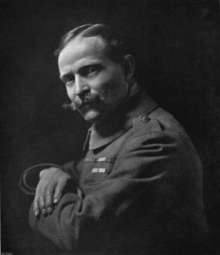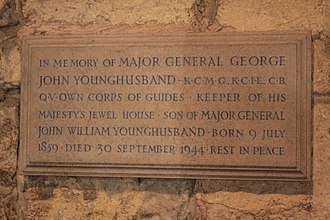George Younghusband
Major General Sir George John Younghusband, KCMG, KCIE, CB (9 July 1859 – 30 September 1944) was a cavalry officer and major-general in the British Indian Army.
Sir George John Younghusband KCMG KCIE CB | |
|---|---|
 | |
| Born | 9 July 1859 Dharmasala, India |
| Died | 30 September 1944 (aged 85) Crickhowell, Wales |
| Allegiance | |
| Service/ | |
| Years of service | 1878–1917 |
| Rank | Major-General |
| Unit | 17th Foot Queen Victoria's Own Corps of Guides |
| Commands held | Queen Victoria's Own Corps of Guides 3rd Battalion Imperial Yeomanry 26th (Younghusband's Horse) Battalion Imperial Yeomanry Fyzabad Brigade Derajat Brigade Aden Brigade 28th Indian Brigade 7th (Meerut) Division |
| Battles/wars | Second Afghan War 1879–1880 Mahdist War 1885 North West Frontier 1886 Third Burmese War 1886–1887 Chitral Relief Force 1895 Spanish–American War 1898 Second Boer War 1899–1902 Mohmand expedition of 1908 First World War 1914–1917 |
| Relations | John Younghusband (father) Francis Younghusband (brother) Charles Younghusband (uncle) George Younghusband (son) Eileen Younghusband (niece) |
| Other work | Keeper of the Jewel House Author |
Younghusband was commissioned into the 17th Foot in 1878. He later transferred to the British Indian Army's Guides Cavalry and served in several conflicts, including the Second Afghan War, the Mahdist War, the Third Burmese War, the Second Boer War and finally in the First World War. Due to wounds received on the battlefield, he was forced to retire from the army in 1917.
In his later life he became a noted author of several books, and the Keeper of the Jewel House at the Tower of London, until his death on 30 September 1944, at Crickhowell in Wales.
Early life
George John Younghusband was born on 9 July 1859, at Dharamshala in India, the eldest son of Major-General John William Younghusband and Clara Jane Shaw, and the elder brother of Francis Younghusband. He was educated at Clifton College and the Royal Military College Sandhurst. In May 1878, after graduating as the Queen's (India) Cadet, he was commissioned, as a second-lieutenant, into the 17th Foot, on probation for the India Staff Corps.[1][2] He fought in the Second Afghan War and was promoted to lieutenant on 15 March 1880, before transferring to the India Staff Corps, in October 1883.[3][4]
Indian Army
After joining the Indian Army he was involved in several conflicts in a short period of time. The 1885 Mahdist War, operations on the North West Frontier in 1886, and in the Third Burmese War.[4] His next promotion came on 1 May 1889, when he was promoted to captain.[5] Six years later, in 1895, he was mentioned in dispatches, while serving as the Brigade Major for the 4th Brigade, part of the Chitral Relief Force.[4][6] He was further recognized by promotion to brevet major in January 1896.[7] The following year, he was on 22 January 1897 appointed to a staff position as deputy assistant adjutant-general in Sirhind, under the Punjab Command.[8] In 1898 he was appointed as a military observer during the Spanish–American War in the Philippines,[4] and in May that year promoted to substantive major.[9]
Command

Younghusband's first command came during the Second Boer War, when he was promoted to temporary lieutenant-colonel and commanding officer of the 3rd Battalion Imperial Yeomanry on 20 January 1900.[10] He left Liverpool with the battalion on board SS Winifredian in late January 1900,[11] arriving in South Africa the following month. While commanding the battalion he was mentioned in dispatches in 1901.[12] The same year he received a brevet promotion to lieutenant-colonel and was appointed a Companion of the Order of the Bath (CB).[13][14] He left the 3rd to command the 26th (Younghusband's Horse) Battalion Imperial Yeomanry in December 1901,[15][16] and was again mentioned in dispatches in June the following year.[17] He was wounded, and in late May 1902 left South Africa on the SS Roslin Castle which arrived at Southampton the following month.[18] He relinquished the command of the 26th battalion on 30 August 1902.[19]
After that war he was promoted to colonel in April 1905.[20] He was then involved in the Mohmand expedition of 1908.[4] Then in February 1909, was promoted to temporary brigadier-general while serving on the General Staff.[21] In 1909, he became commander of the Fyzabad Brigade, part of the 8th (Lucknow) Division, and the Derajat Brigade from 1911. The same year he was promoted to major-general.[22] He was still in command, when appointed a Knight Commander of the Order of St Michael and St George (KCMG) in 1913.[23]
In the First World War, Younghusband was given command of the 28th Indian Brigade, part of the 10th Indian Division. They were initially deployed to defend the Suez Canal. Until 1916, when the brigade was sent to take part in the defence of Aden. It then moved to Basra to participate in the Mesopotamia Campaign. During the subsequent operation Younghusband was again mentioned in dispatches.[24][25] His last command position was in 1916, as commander of the 7th (Meerut) Division, still in Mesopotamia, but he was forced to relinquish that position due to wounds received.[4]
Family and later life
In March 1917, King George V appointed Younghusband as the Keeper of the Jewel House at the Tower of London.[26] Then in April 1919, the King approved his retirement from the army.[27] He was not entirely finished with the army however and in January 1928, he was appointed the Regimental Colonel of the 10th Queen Victoria's Own Corps of Guides Cavalry (Frontier Force) and of the 5th Battalion, (Queen Victoria's Own Corps of Guides) 12th Frontier Force Regiment.[28]
His son Brigadier George Edward Younghusband, of the 3rd The King's Own Hussars, served with the 2nd Armoured Division during the Second World War.[29]
George John Younghusband died on 30 September 1944, aged eighty-five, at Crickhowell in Wales.[30]
Notable works
- The Crown Jewels of England (1919)
- Eighteen Hundred Miles on a Burmese Pony
- Forty Years a Soldier (1923)
- Indian frontier warfare (1898)
- The Jewel House (1920)
- A Short History of the Tower of London (1926)
- The Philippines and Round About, with some Account of British Interests in these Waters
- Polo in India
- The Queen's Commission
- The Relief of Chitral (1895)
- A Soldier's Memories in Peace and War (1917)
- The story of the Guides (1908)
- The Tower from Within (1918)
- The Story of the Guides (1908)
- Exploits of Asaf Khan
- A Soldier's Memories in Peace and War (1917)
References
- "No. 24577". The London Gazette. 30 May 1878. p. 2775.
- "G. J. Younghusband". Journeys to Keng Tung. Retrieved 23 December 2013.
- "No. 25283". The London Gazette. 30 October 1883. p. 5148.
- "George Younghusband". King's College London. Retrieved 23 December 2013.
- "No. 25955". The London Gazette. 19 July 1889. p. 3896.
- "No. 26680". The London Gazette. 15 November 1895. p. 6177.
- "No. 26701". The London Gazette. 21 January 1896. p. 358.
- Hart′s Army list, 1901
- "No. 26987". The London Gazette. 15 July 1898. p. 4275.
- "No. 27157". The London Gazette. 26 January 1900. p. 515.
- "The War - The Imperial Yeomanry". The Times (36052). London. 30 January 1900. p. 5.
- "No. 27305". The London Gazette. 16 April 1901. p. 2604.
- "No. 27306". The London Gazette. 19 April 1901. p. 2704.
- "No. 11343". The Edinburgh Gazette. 1 October 1901. p. 1094.
- "No. 27399". The London Gazette. 21 January 1902. p. 452.
- "No. 27434". The London Gazette. 16 May 1902. p. 3252.
- "No. 27443". The London Gazette. 17 June 1902. p. 3974.
- "The Army in South Africa - Return of Troops". The Times (36798). London. 19 June 1902. p. 8.
- "No. 27476". The London Gazette. 23 September 1902. p. 6079.
- "No. 27782". The London Gazette. 7 April 1905. p. 2638.
- "No. 28245". The London Gazette. 27 April 1909. p. 320.
- "No. 28516". The London Gazette. 25 July 1911. p. 5551.
- "No. 12526". The London Gazette. 3 January 1913. p. 3.
- "No. 29632". The London Gazette (Supplement). 20 June 1916. p. 6174.
- "No. 29576". The London Gazette (Supplement). 9 May 1916. p. 4660.
- "No. 13073". The Edinburgh Gazette. 24 March 1917. p. 669.
- "No. 31894". The London Gazette. 11 May 1920. p. 5367.
- "No. 33347". The London Gazette. 13 January 1928. p. 299.
- "LHCMA Collections". King's College London. Retrieved 22 December 2013.
- "Have you a tiger in your family?". The Royal Leicestershire Regiment. Retrieved 23 December 2013.